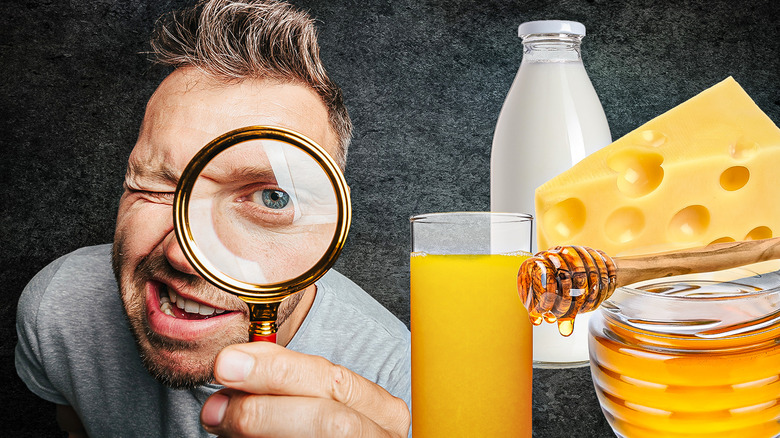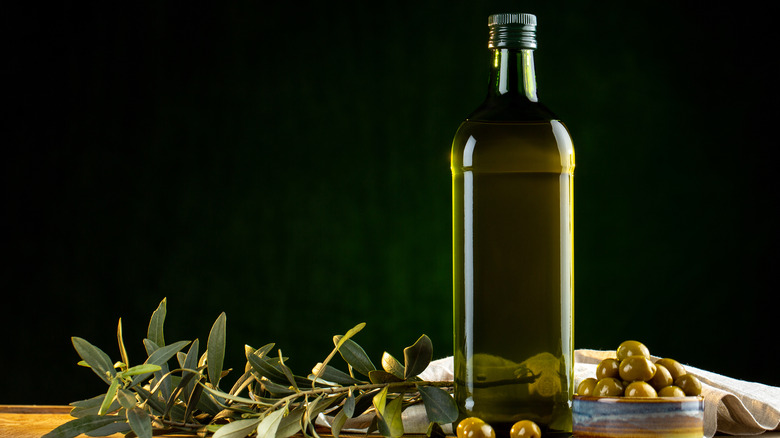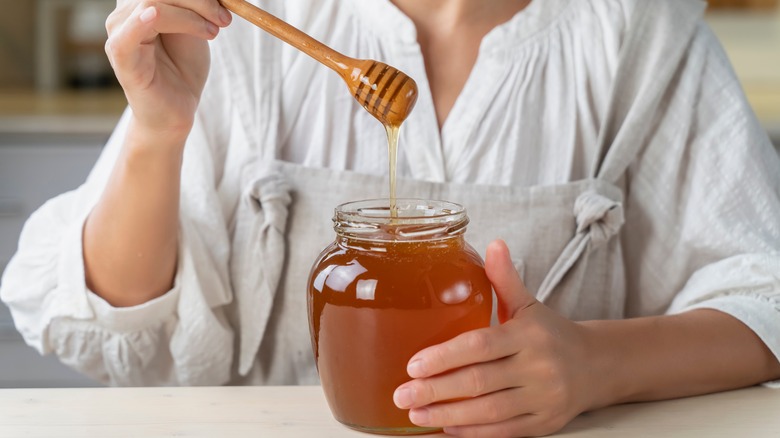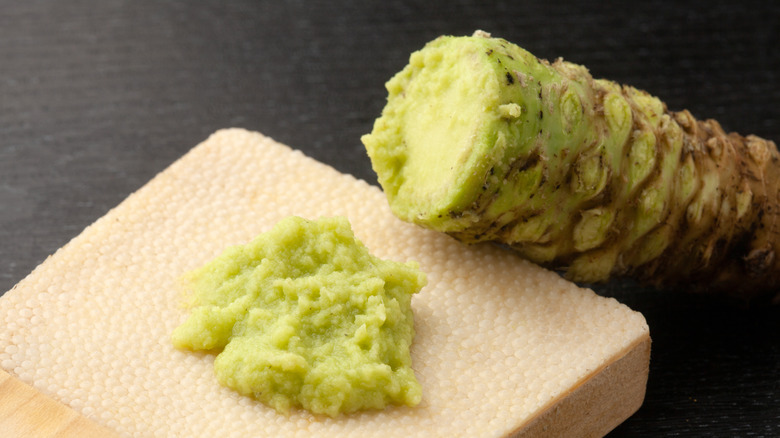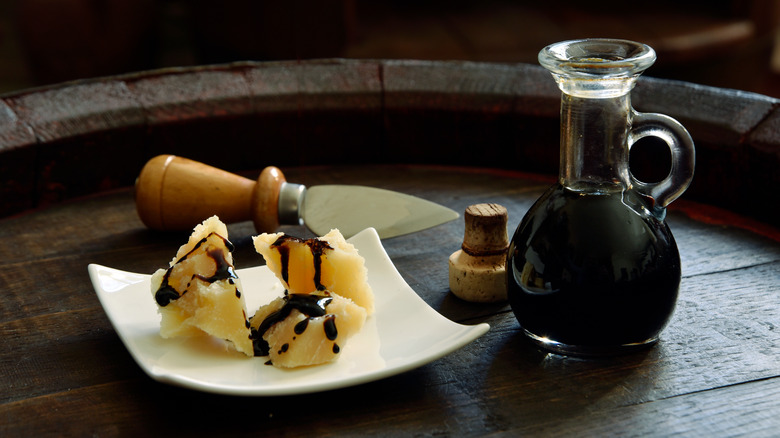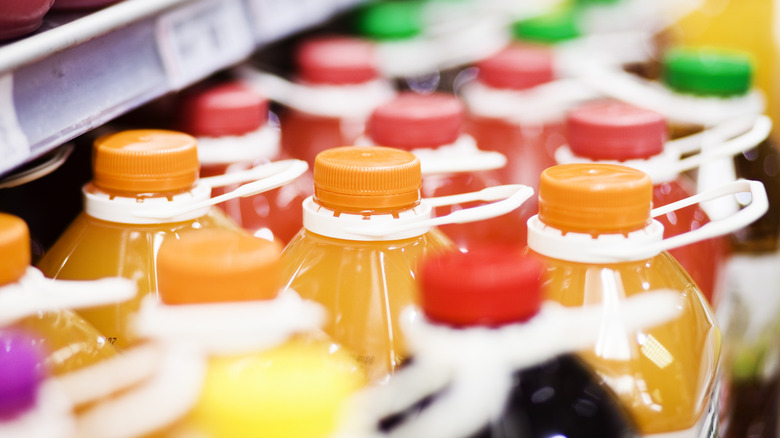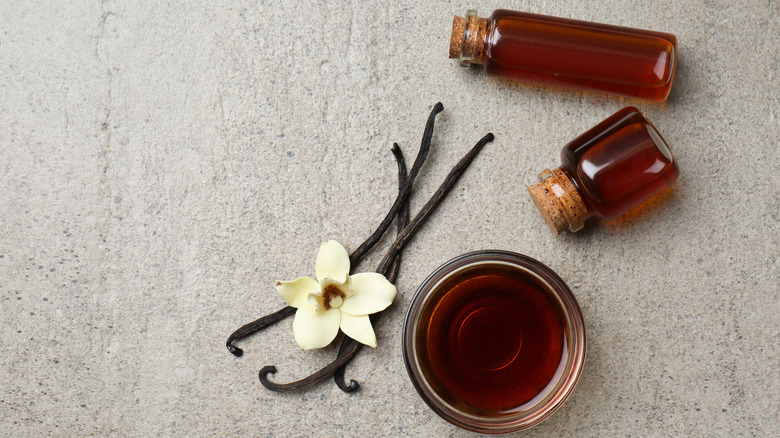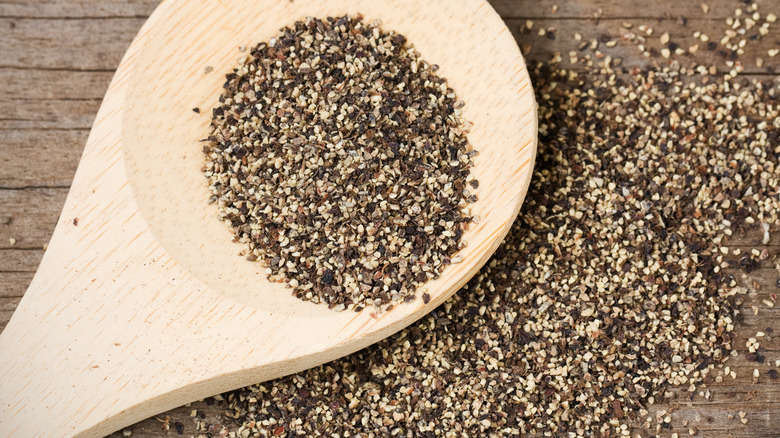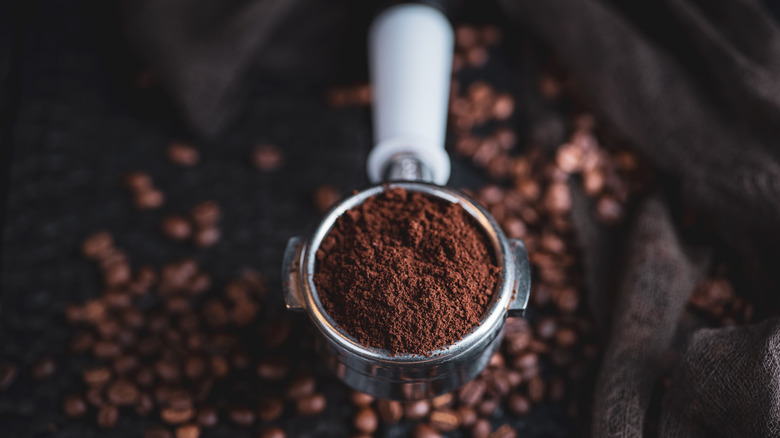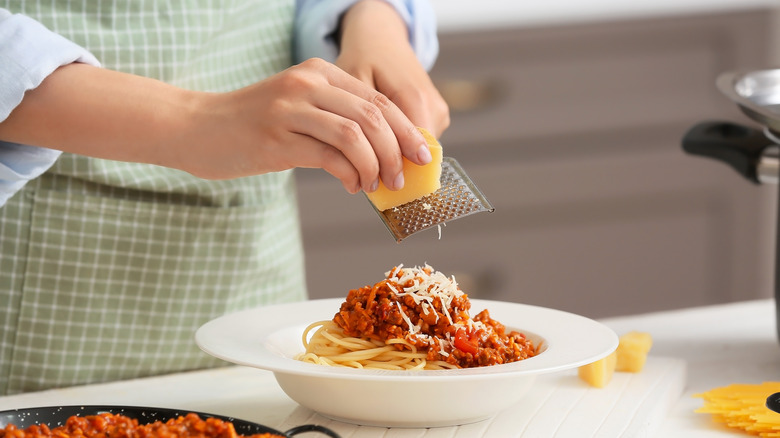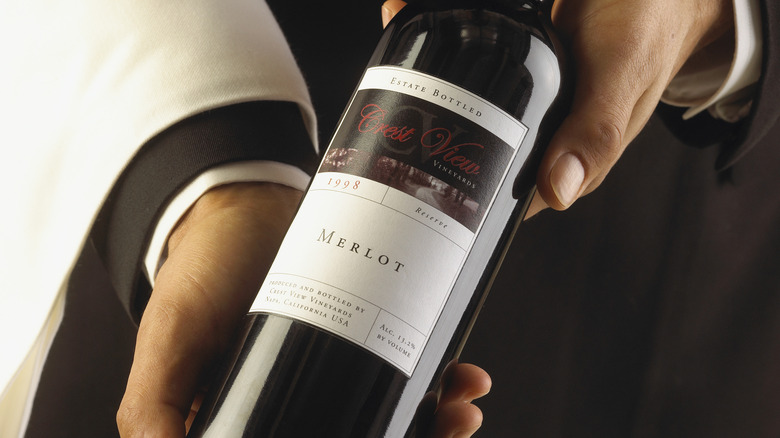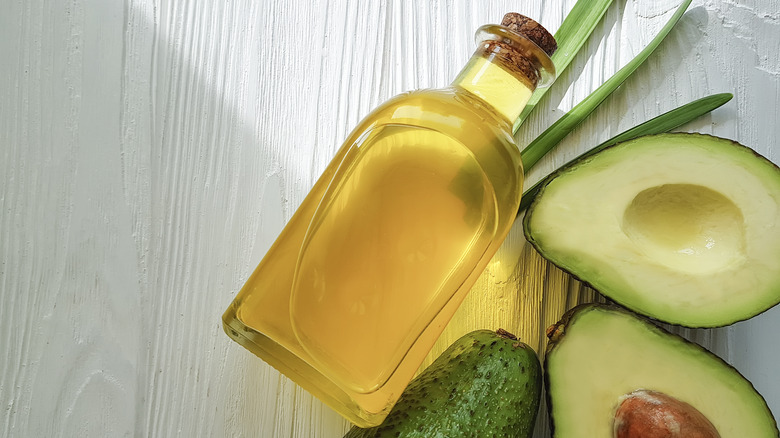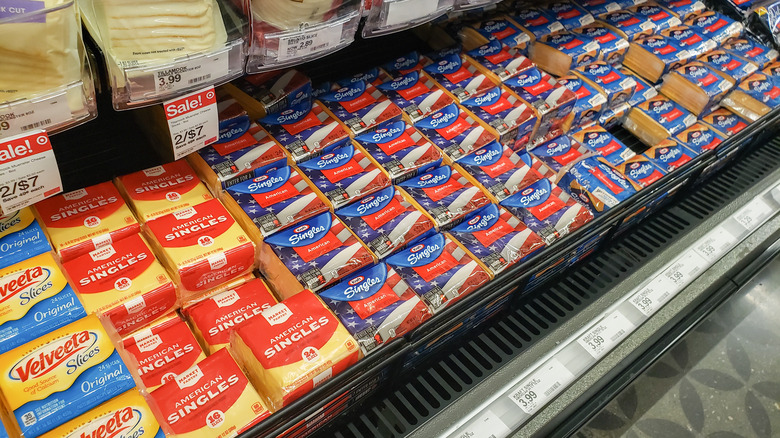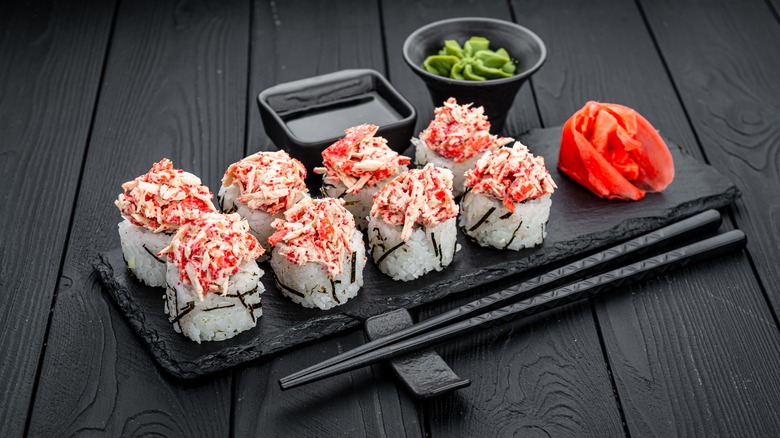Signs You're Eating Imitation Foods
Let's be real. No one likes the feeling of getting duped, especially when it comes to food. As it turns out, that is exactly what happens when you think you're buying a specific product but it turns out to be a phony fraud. So, how often does this occur? Very frequently, we're sorry to say. From condiments to meat and everything in between, there are many false advertisements out there, and it's time you were made aware.
We're revealing the top signs that may indicate the food you're purchasing isn't what it claims to be. Between added ingredients and false promises, you'll find the foods sold in grocery stores and restaurants aren't always what they seem. Join us as we uncover the facts about the foods you purchase, including the good, the bad, and the ugly. So, get ready ... we're about to unearth several little-known industry details that will shock you.
Olive oil that doesn't include a harvest date
There's no doubt that pure olive oil offers exceptional health benefits. The blast of antioxidants, anti-inflammatory properties, and other advantages make it amazing for a variety of purposes (via Healthline). But how can you know that your olive oil is legit?
Sadly, just because olive oil is labeled as authentic doesn't mean it is. According to a 2021 study published by the Department of Drug Chemistry and Technology in Rome, much of what is sold in stores or distributed directly from producers contains distinctly different chemical makeups with regard to color, anti-radical benefits, and other parameters. These findings demonstrate the variability of olive oil sold today, making it a real chore to distinguish the real from the fake.
Thankfully, there are a few surefire ways to decipher the good from the bad. Start by looking for oils labeled "EVOO" or extra virgin olive oil. Although this isn't a guarantee that the oil is the highest quality, it will at least give you a better chance of selecting an oil that's legit when compared to one without this labeling. Additionally, scan the label for specifics regarding where the olives came from and when they were pressed. Names of production mills are a bonus, as are the olive varieties used in production. Lastly, pure olive oil should smell pleasant with a fresh grassy taste; anything bland or greasy likely isn't legit.
Honey that instantly dissolves in water
There's real honey and then there's fake honey. Thankfully, it's rather easy to tell the difference between the two if you know what to look for. The fake stuff contains added ingredients that make it perform unlike the real thing. It often has a cheaper price tag and may even look different since some varieties are diluted with water to produce larger volumes.
To know for sure, try dissolving your honey in water. Real honey won't diffuse but will likely sit at the bottom in a large glob. Fake honey, on the other hand, will quickly dissolve thanks to added ingredients that make it easier to combine with the water. Another key difference between authentic and phony honey is the differing texture. The consistency of real honey is thick and doesn't easily run off your fingers. In contrast, you can expect fake honey to have a runny and drippy characteristic and remain liquid when exposed to air. Who knew?
Wasabi that is velvety smooth
Wasabi is a spicy Japanese paste that comes from the Brassicaceae plant family. It is known for waking up the taste buds with its unique attributes, but all too often, the condiment is imitated due to its expensive price tag.
So, what's the difference between real wasabi and an imposter? The main sign to look out for is texture. If your wasabi is velvety smooth, it is an indicator that it may be mixed with dyes and other ingredients (such as ordinary horseradish). Instead, authentic wasabi is freshly grated and gritty. The flavor delivers a short burst of spice that shouldn't linger the way fake wasabi often does. This characteristic is what makes the real deal a perfect match for sushi and other light seafood meals.
We should also mention that since true wasabi is so scarce, it is almost certain that you won't be able to find it in the grocery store. Still, you may be able to snag authentic wasabi in a restaurant, but even then, this Japanese delicacy can prove to be a rare find.
Balsamic vinegar containing water and additives
Did you know that true balsamic vinegar shouldn't contain added ingredients? Unfortunately, most types of balsamic vinegar on the market include a hodgepodge of additives, leading to the degradation of what most people think is authentic. The result is a bottle of less potent, less flavorful, and less healthy vinegar, especially when stacked up against the real thing.
Balsamic vinegar is known for its health benefits, which include low-calorie and sodium levels (via WebMD), as well as its peppy taste. It pairs great with oils and spices to create a mouthwatering vinaigrette and it is also used to impart life to stews and pasta. Interestingly enough, this hot commodity is only made with grapes grown in certain areas of Italy. Nevertheless, there are ways to determine the genuineness simply by looking at the label. For starters, the real deal requires a seal confirming its designation of origin. Check the ingredients list for additives, including water, sugar, filler, coloring, and other suspect elements. If you see these components, know that you aren't buying balsamic vinegar in its purest form.
Fruit juice that contains added sugar (and other icky ingredients)
Is your fruit juice what it claims to be? That depends. Fruit juice sold in stores is often deceptively labeled with images of fresh fruit that may lead you to believe the drink offers nothing but pure goodness. The fact of the matter is that the beverage often contains added sugar and artificial coloring despite a promising label.
To know what you're getting, always look for the phrase "100% juice" printed on the container. Juices that have added sugars such as high fructose corn syrup aren't worth your time and can even prove detrimental to your health when consumed in excess. Artificial dyes are also a no-go, as some colorings are linked to unwanted behavior in children (via Healthline).
Remember, pure fruit juice will likely contain a blend of fruit, puree, and water — not added sugars, dyes, or colorings. So, if you see extra ingredients on the label, don't be fooled; these drinks aren't good for you, and you're better off skipping them.
Vanilla extract labeled as vanilla flavor
Vanilla extract is a baking essential, especially when added to sweet desserts like cookies and cakes. But as most seasoned bakers know, there's a difference between pure vanilla extract and vanilla flavoring. Pure vanilla extract comes from vanilla beans and alcohol. The process yields a uniquely flavored liquid used in baked goods to amplify their taste.
Imitation vanilla may look similar but it isn't the real thing. Bottles labeled as "vanilla flavor" or "imitation vanilla" signify that the liquid in the package isn't authentic. Instead, these products likely contain vanillin, a more robust yet less complex manufactured version of vanilla. Vanillin comes from guaiacol, often produced from petroleum.
Of course, there are instances in which vanilla flavor works quite well, especially if you're baking on a budget. However, if you're looking to pick up pure vanilla from your local grocer and find these cheaply priced alternatives, take note that you're actually buying an artificial flavoring.
Black pepper with no aroma or flavor
Black pepper is an American kitchen staple that can be found in practically every cupboard. That's why we were shocked to find out that most of the black pepper available on the market isn't all it's cracked up to be.
Authentic black pepper is made from ground peppercorns which have a distinctive shape and physical characteristics that are easily identifiable through a microscope. Still, commercial manufacturers find ways to mimic it by adding other similarly colored substances to the mix. These unwanted add-ins often include coffee pieces and even finely ground stones. If this sounds unappetizing, we can empathize. The best way to prevent becoming duped by black pepper may be to grind the whole peppercorns yourself.
Nowadays, there are several types of black pepper grinders on the market, many of which are sold right alongside pre-ground pepper. They generally feature a plastic twist-top grinder and come already supplied with peppercorns to make the process easier. Yes, the price point is higher, but at least you'll have peace of mind knowing your black pepper is free of rocks and stale coffee. In our estimation, the switch is absolutely worth it.
Coffee that already comes flavored
If you love purchasing coffee with assorted flavor essences, we're disappointed to inform you that this might spell bad news for its quality. Coffee that comes pre-flavored is likely low-grade, especially given that the flavorings themselves aren't usually natural. True naturally-flavored coffee beans will expressly state their purity on the packaging, but in most cases, it's all artificial. Not to mention, adding aromas is sometimes used to mask the flavor of shoddy coffee grains.
Still, there are several ways you can tell great coffee beans from the bad stuff. First, look for coffee packages labeled as 100% arabica beans. These are known for being higher quality than commonly used robusta beans. You'll also want to look for the specific origin of the beans, along with the day they were roasted. All of these signs can help you distinguish high-quality coffee from cheap and unappetizing alternatives.
Parmesan cheese sold as a powder
Parmesan cheese is a much-loved Italian staple used in a number of savory recipes. From topping pasta dishes to salads, this versatile cheese adds a unique salty and nutty flavor to anything it graces. Unfortunately, most types of parmesan cheese sold in grocery stores aren't authentic. To distinguish the real from the fake, you'll need to pay close attention to the details, most of which will probably go unnoticed if you don't know to look for them.
The first way to determine whether or not parmesan cheese is real is to read the label. Brands that bear the words "Parmigiano Reggiano" are legally protected according to PDO guidelines and can only be named as such if they meet those specific standards. Another way to detect a parm cheese fraud is to check the outer edge. Authentic Parmigiano Reggiano will have the name stamped across the rind. Just know that when buying a wedge of cheese, the rind may not contain the entire phrase; in that case, you'll want to look for some evidence of stamping instead.
Wine sediment that doesn't move
Feeling fancy after copping that bottle of aged wine? Go you! But know that some wine on the market is fake, and it can be hard to determine which is which. This is especially common with aged wines that often garner a small fortune in auction houses. One of the ways that you can tell an aged wine from standard wine that is only pretending to be aged is by observing its sediment.
Most aged red wines contain sediment, and you'll need to pay attention to the attributes of the sludge. Gently tip the wine bottle at an angle to see if it moves. If it does, it is at least one sign that your wine is indeed aged. If it stays stuck at the bottom, it may be time to look for another brand. It turns out, some illegitimate manufacturers alter the sediment to make a wine bottle look older. The thing is, this imitation sediment doesn't normally shift in the bottle, making it easier to determine a counterfeit.
Avocado oil that is is more yellow than green
Avocado fruit has increased in popularity in America, and the same can be said about its oil. It is hailed for its healing properties and health benefits (via Healthline), though coming across authentic avocado oil these days can be difficult.
According to a 2020 study published in Food Control, many avocado oils found in markets are tainted with soybean oil despite claims of being "refined" or "extra virgin." These oils may seem more yellow than green, and thus, exhibit signs of adulteration. Unfortunately, it is often difficult to see the actual color of avocado oil when it's stored in dark bottles on grocery store shelves.
So, what's the solution? Do your research. Check out avocado oil brands that have a high reputation so you know what you're buying before you spend your hard-earned cash. Also, remember that avocado oil should taste fresh, grassy, and slightly buttery. Stale-smelling avocado oil is often yet another indication that something is amiss.
Maple syrup labeled as pancake syrup
Ah, maple syrup. The unique taste and velvety texture is the hallmark of a delicious breakfast, but it's not all created the same. If you've ever slathered your flapjacks in a rich brown sap that only cost you a few bucks, we need to talk. Though we admit these popular syrups are incredibly tasty, unfortunately, most don't classify as being legitimate.
Real maple syrup is typically found tucked alongside other syrups and stamped with a much higher price tag. The phony versions are usually labeled as "pancake syrup," immediately informing you that they aren't legit. Actual maple syrup comes from maple trees and won't contain any ingredients except the maple syrup itself. Pancake syrup, on the other hand, often contains artificial flavorings, high fructose corn syrup, and other additives. Though delicious, these illegitimate frauds won't offer the same health benefits as real maple syrup.
The next time you're in the grocery store, take a peek at the label when choosing a bottle of maple syrup. Look for short ingredient lists and appropriate phrasing on the packaging.
Cheese labeled as a cheese product
We've got some bad news for you cheese lovers out there. Many of the "cheeses" you find lining store shelves might not be cheese at all. As you might imagine, brands that come sold unrefrigerated on shelves are among your worst offenders, but there's more. Classic American cheese, like Kraft Singles, doesn't count as real cheese either.
If a product doesn't meet the USDA guideline requirements, it can't be labeled as cheese, even if it contains some amount of cheese. Instead, the product must be marketed as a "cheese product" so that buyers can be informed.
Does this mean you should throw out the fake cheese you've got stored in your home? Not quite. Though processed cheese has its pitfalls, we have to admit that it can make some pretty killer grilled cheese sandwiches. Just remember that processed cheese won't emulate the complex and unique flavors of real cheese, so keep that in mind when deciding what to use.
Crab meat labeled as crab sticks or crab flavored
It's no secret that imitation crab is available at most grocery stores, but there are other ways manufacturers may trick you into thinking crab meat is real when it isn't. Crab meat is expensive, typically because of its high demand and limited supply. It is tender, flaky, and mild, which makes it a popular seafood choice that most people can't wait to get their hands on. The problem is while some grocery stores carry genuine crab meat, markets have found a number of loopholes to make it appear like you're buying true crab.
One of the most obvious signs you're eating fake crab meat is to look for packages labeled "imitation crab." Beyond this, you may also see crab offerings labeled as "crab sticks," "crab flavored, " "krab," or "crab seafood." A quick scan of the ingredients list will highlight the fact that these products often contain little to no crab at all. Instead, they consist of a mixture of surimi and cheaper fish produced to mimic the look, feel, and taste of the real thing. Sigh.
